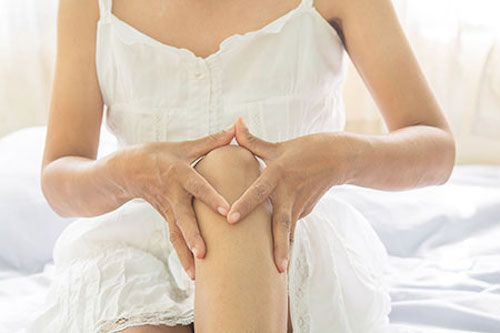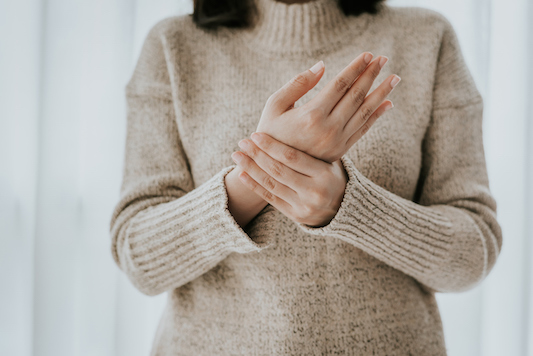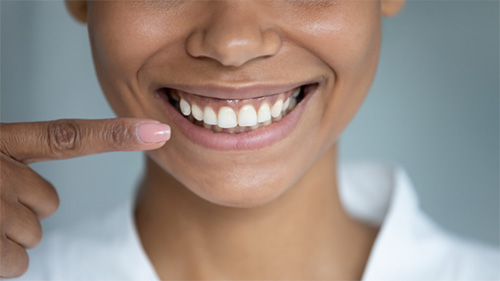By Dr. Sharon Stills, NMD
As we experience pain and swelling in our fingers, wrists, knees or any joint, it’s easy to jump to the conclusion that our joints are “wearing down” from use, like car parts. We may even think we’re developing arthritis. But our bodies are not made up of mechanical pieces with built-in obsolescence; they are made up of living cells that can actually strengthen and grow when fully nourished and used properly.

Many things can lead to chronic joint pain. More often than not, it is the simmering fires of inflammation, not old age. The pain that you feel is your body’s way of telling you that it’s irritated and needs your help. So instead of brushing it off or tuning it out with a pill or two, take the time to listen.
How our joints work
Let’s get a better picture of what a joint looks like. All joints — whether fixed, hinge, pivot or ball-and-socket — are formed when two bones meet. The bones are connected to one another by strong flexible bands called ligaments. Muscles, which provide the pulling force to move the joints, are attached to the bones by tough fibrous tendons (sinew). Both the ligaments and tendons are housed in protective mucous sheaths.
A healthy joint is surrounded by a joint capsule, and between the muscles and the joint capsule lie protective fluid-filled pockets called bursae. Within a joint capsule, the bones are protected from wear and tear by a pliable lining made up of cartilage, a smooth sheet-like coating that allows bones to move directly over each other, and synovium, which is more like a cushiony “inner-tube” that protects and lubricates the joint surfaces as well as brings nourishment to the surrounding tissues. These various tissues and fluids both within and outside of the joint serve as packing and reduce friction between all the moving parts.
If something happens to just one aspect of the joint, it can lead you to experience pain.
Happily, there are so many ways to naturally soothe your pain and calm the inflammation at its root, arthritis or not, including the most inexpensive medicine around: food. Let’s look at the possible causes of your joint pain and explore some solutions that will have you moving — and feeling — like your old self again.
Common causes of joint pain
Joint pain can flare up for a number of reasons — some of which may be overlooked by conventional practitioners. Many women, even younger women, wonder if their pain is being caused by arthritis. Sadly, it is estimated that one in five Americans has been diagnosed with some form or arthritis. There are over a hundred different arthritic conditions, rheumatoid arthritis and osteoarthritis being the most well known.
Rheumatoid arthritis is an autoimmune disease causing inflammation in the synovial fluid of the joint. It sets itself apart from other forms of arthritis with some telltale features: a general appearance in the hands or feet, a hot or warm feeling in the joint, stiffness for over 30 minutes in the morning, the same joint affected on both sides of the body, polyarthritis (more than one joint affected at a time), and pain that can last through the night. With this form of arthritis, most women notice the pain eases the more they use the joint.
Osteoarthritis, on the other hand, feels worse the more we exercise and as the day wears on. Also linked to inflammation, this type of arthritis can be traced back to a breakdown in your joint cartilage. It generally affects the hips, knees, spine, hands and feet and develops as more of a wear-and-tear situation, whereas rheumatoid arthritis is closely tied with genetic factors that lead to an autoimmunity problem. It’s hard to tell if our overworked joints have progressed to arthritis, but new technology in thermal imaging will soon be able to show us how much inflammation is present in our joints.
There are many other causes of joint pain outside of arthritis. The table at right lists a few types of arthritis and non-arthritic conditions commonly associated with joint pain.
Investigating your own joint pain
To get to the real root of joint pain, here are key questions, including some about seemingly less related issues that may contribute to the pain, issues that may be emotional as well as physical irritants.
Inflammatory causes of joint pain
Forms of arthritis associated with joint pain
- Osteoarthritis (OA), also known as degenerative joint disease, or DJD
- Rheumatoid arthritis (RA)
- Ankylosing spondylitis(AS)
- Psoriatic arthritis
Other causes of joint pain
- Injury
- Muscle strain
- Bursitis
- Food allergies
- Leaky gut
- Menopause and perimenopause
- Lyme disease
- Sjögren’s syndrome
1. Is this pain relatively new?
Think back over the past few months or years. If you’ve had a sports injury or trauma, such as an accident or a fall, your pain could be related to that. It’s not at all unusual for joint pain to develop and escalate after the date of the injury itself. Torn ligaments and tendons lack blood flow, so they can’t heal themselves and must be repaired surgically. Sprains can take a long time to repair themselves. With any kind of injury, it’s important to give your body the right nutritional support and enough time to heal.
2. Is the pain seasonal or related to changes in the weather?
Complaints of joint pain increase during colder weather because your blood doesn’t circulate to your extremities as well in the colder months. And it doesn’t help that pain receptors are more sensitive in cold weather. A drop in barometric pressure, such as before a rain or snow storm, can also cause any inflamed tissues to expand and become more painful.
3. Can you associate the pain with any specific activity?
Overuse and misalignment are common causes of joint pain, whether caused by a day of stress and strain, or accumulated over a period of years. This kind of mechanical injury can inflame the bursae (causing bursitis), or the tendons (causing tendonitis), or eventually wear down the cartilage and cause osteoarthritis. For instance, do your knees hurt only after a work-out? Does your hip ache only after a long drive? Does your neck or elbow hurt if you type for more than 30 minutes? Desk-related complaints can often be solved by making ergonomic adjustments to your workspace for increased comfort and prevention of repetitive injury.
4. Is it the muscle or the joint?
You may actually be experiencing pain in the muscles close to a joint and think that the joint is the problem. Muscle pain is generally associated with over-exercise or movement that has caused excess strain on the muscle, ligament or tendon. This kind of pain should resolve within two to three days of rest. You might also notice a point of tenderness or “trigger point” on the muscle in this case. Muscle pain may also respond positively to stretching or massage therapy. Dr. Sharon Stills has also had good success using homeopathic injection therapy and prolotherapy, a pain-relieving procedure that relies on injections of an “irritant solution.”
5. Is your pain worse in the morning?
It might be useful to start tracking your pain by using a wellness diary: if your pain lasts for longer than a half hour in the morning and gets better during the day, there is a possibility that it could mean rheumatoid arthritis. Look closely at your sleeping habits and mattress. Changes here may be a simple solution. It’s also interesting how some women who eat (or drink) refined carbohydrates at night are also more likely to have fluid retention and morning pain, and how changing just this one habit can turn joint pain around — almost overnight.
6. What’s going on right now in your life?
Joint pain may be reflective of some aspect of a woman’s “inner” life. In Eastern medical traditions, pain is a sign of energy blockage, and this can also mean emotional energy and life force. Pain in the knees may indicate an inability to move forward for fear of criticism or a lack of self-acceptance. Some women feel neck or back pain only while they’re at work or around certain people who make them feel tense or burdened. And while it may seem like a big leap to connect emotional stress with joint pain, we have all come to accept the idea that the body stores tension in the muscles, so it shouldn’t be difficult to accept the notion that your emotional life can impact your joints.
7. What is your family history?
Some forms of arthritis, such as rheumatoid arthritis, are connected to genetic make-up, and if anyone in your family has had it, this places you at higher risk — but not the certainty — of developing it. Just as important are the emotional qualities of your childhood and upbringing. These emotional overtones may be carried forward on a subconscious level and manifest themselves in our bodies as pain or disease in adulthood that keeps us stuck in a certain pattern. Like a needle stuck in a groove, we keep playing the same scratchy refrain. Luckily, our bodies often know better than we do what they need to be healthy — and often it’s simply a matter of gaining the strength to pick the needle up and put it on another song.
What’s important for every woman to know is that whatever the cause of your joint pain, there are ways to increase your mobility and decrease — or even eliminate — your pain. And the best place to start in almost every case is to address issues of inflammation.
Joint pain and inflammation
Most forms of joint pain involve some kind of inflammation — either local or systemic. When injured, a chain of events in your immune system known as the inflammatory cascade is triggered. In a careful balance of give and take, this process starts with pro-inflammatory hormones calling out for white blood cells to clean up damaged tissue and clear out infection. This is what causes the redness, swelling and pain we often see with injury.
Next, anti-inflammatory compounds take over to heal the area once the threat is diminished. When this process, known as local or acute inflammation, waxes and wanes in response to injury it’s a sign of a healthy immune system. Yet when the symptoms of inflammation don’t disappear, it tells us that your immune system is unable to turn itself off when it should.
Just as the flame of a burning fire can help or hurt, our body’s internal fire has the dual power to heal and to cause us pain. Think of inflammation like a burner on your gas stove; local injuries and infections cause our bodies to turn the flame up high in the area of the injury, while with systemic or chronic inflammation, our bodies keep the burner on simmer, even when we’re not suffering an injury. This slow burn has been associated with range of health conditions and degenerative diseases, including asthma, allergies, skin problems, insulin resistance, irritable bowel syndrome, heart disease, Alzheimer’s and yes, arthritis.
In terms of our joints, pain stemming from an injury or even short-term overuse can set off localized inflammation in the cartilage, tendons, or bursae. As the injury heals, players in your inflammatory cascade will perform their tasks and disappear. If the inflammation persists it can lead to a more chronic condition. Luckily, we now have a few tests that tell us a great deal.
Testing for inflammatory markers
There are blood tests for inflammatory markers, such as CRP (C-reactive protein) and alpha-lipoprotein (some lump homocysteine in this group as well) to determine whether women are more likely to develop inflammatory conditions. Trace amounts of CRP are healthy. And there may certainly be a rise in CRP with a local injury or an acute infection. But prolonged elevated CRP levels indicate systemic inflammation. Other inflammatory markers Dr. Stills looks for include fibrinogen and erythrocyte sedimentation rate (ESR or “sed” rate.)
Though CRP and other markers of inflammation are easy to test, many conventional doctors aren’t sure how to treat elevated levels and end up avoiding these tests altogether. But major dietary changes and nutritional supplements that can moderate these inflammation markers.
Many women think they have to accept joint pain and learn to live with it for the rest of their lives (which often means relying on regular use of NSAID’s like Motrin, Tylenol and Aleve, even though they can cause stomach, liver and kidney concerns with long-term use). Let us assure you that this is just not the case! Chronic inflammation and its associated diseases can often be overcome or prevented with a number of integrative and natural approaches. Start by looking at your hormonal balance.
Hormones and “menopausal arthritis”
Lots of women notice joint pain for the first time during perimenopause. Studies have shown that lower estrogen levels during perimenopause and menopause are frequently associated with joint pain. Although the relationship between estrogen and our joints is not completely understood, we do know that estrogen has an anti-inflammatory effect in the body.
Estrogen quiets the inflammatory “noise” in our joints — along with the noise in many other parts of the body! As hormone levels initiate their natural shift during perimenopause, any imbalances that estrogen has quietly been covering begin to rise to the surface, leaving us perplexed by issues we never before encountered. The truth is, most of us probably had inflammation in our joints for some time, but estrogen was cloaking our sensitivity to the pain.
A lot of women find their pain eases when their hormones return to balance, though for some, this is only one piece of the picture. The foods you’re eating can be the determining factor in restoring balance and quieting the inflammatory noise.
Joint pain, nutrition and digestion
Though food is often looked at solely in terms of its impact on weight gain, it’s also the safest, most effective, and cheapest medicine for preserving and restoring overall health. Many foods contain micronutrients that positively impact the inflammatory cascade upstream of where medications such as Advil, Motrin, and COX-2 inhibitors act, making these drugs (and all their side effects) avoidable. Foods rich in omega–3 fatty acids are a perfect example.
Many women who suffer from joint pain also report digestive problems. This is because persistent imbalances in the GI tract (such as dysbiosis, leaky gut, and inflammatory bowel disease) are often associated with chronic inflammation and allergens. We suggest anyone with joint pain start with an elimination diet or request an ELISA blood test from their healthcare practitioner to pinpoint food sensitivities.
Inflammation-fueling “hot” foods & anti-inflammatory “cooling” foods
Hot foods — avoid!
- Fried foods
- Red meat from corn-fed animals raised with antibiotics and/or hormones
- Partially hydrogenated (trans) fats (found in margarine, chips, processed baked goods)
- Saturated fats (e.g., animal fats such as butter and lard)
- Corn oil, safflower oil, sunflower oil or soy-based oils
- Soft drinks, including both diet and regular soda and fruit juices
- All forms of sugar, including natural and refined
- White flour and other processed grains
- Most fast-food and prepackaged meals
Cool foods — eat more!
- Dark green vegetables (including spinach, kale, and seaweed)
- Antioxidant-rich fruits and vegetables, as well as vitamin C and E supplements
- Raw nuts and seeds (including almonds, pecans, and walnuts)
- Omega-3-rich fish, such as salmon, mackerel, and anchovies (or supplements containing EPA/DHA)
- Cold-pressed oils such as virgin olive, macadamia nut, grapeseed, and avocado
- Soups made from scratch with free-range poultry or meat bones (boiled bones can release glucosamine and chondroitin)
- Limited amounts of gluten-free whole grains, especially amaranth, millet, and quinoa
Common problem foods associated with inflammation include citrus, corn and corn products, dairy products, gluten grains (wheat, barley, oats, rye, spelt, kamut), yeast, and eggs, as well as members of the nightshade family — tomatoes, potatoes, peppers, and eggplant. Figuring out what you’re sensitive to may just make all the difference with your efforts to reduce joint pain.
Ayurvedic and Chinese medical practitioners have been using food as medicine for centuries. We’ve learned from these ancient medical practices that some common foods worsen inflammation — these foods are known as pro-inflammatory, or “hot” foods — and others “cool” the fire. Sadly, our Western diet of high-sugar and overly-processed foods is of no help.
Overall, you can’t go wrong by favoring simple, whole foods as opposed to processed convenience foods. Adjusting your diet away from “hot” foods and more toward “cool” foods is a great way to move toward better overall health.
More specifically, there are many natural compounds found in foods that have long been known to be effective anti-inflammatories. With all the controversy surrounding the side effects of NSAID’s (Advil, Motrin) and COX-2 inhibitors (Vioxx, Celebrex), it makes much more sense to look for natural pain relief.
Joint pain and toxicity
Another source of fuel for your body’s internal fire is its toxic burden. Whenever toxic compounds are allowed to build up in the body, inflammation can also increase and send our health into a downward spiral. A toxic chemical soup can accumulate in our organs over time and weigh us down with a toxic load — everything from alcohol and prescription drugs to the chemicals we use to clean our homes. Heavy metals like iron, lead, and mercury are all also linked to joint pain.
And some of us are poorer detoxifiers than others. While we can’t avoid exposure to these substances completely, we can limit their effects on our bodies. If you have a lot of mercury amalgam fillings and suspect they’re tipping the scale on your joint pain, consider talking to a biological dentist — not just your regular dentist — about replacing them with safer materials.
Inflammation and toxic emotions
I encourage women to be aware of emotional toxins too. It’s no coincidence that phrases like “burning mad,” “I was so angry I saw red,” and “She has a fiery temper” remind us of inflammation symptoms. Research has shown a direct correlation between negative emotions such as anger, lack of forgiveness, shame, guilt, fear, and loneliness and an increase in inflammatory conditions. Habitually negative people release higher levels of CRP than happier, calmer individuals.
Studies have also shown that chronic stress impairs the immune system’s ability to shut itself off after the infection or injury is fixed. This is because stress involves the release of the hormone cortisol, which acts as fuel for the pro-inflammatory fire. Additionally, normal hormonal cues that tell the brain everything is okay never make it to their destination. So, the stressed-out body lives in a constant state of emergency, or chronic inflammation, which only adds to the pain in your joints.
Emotions like shame, guilt, and fear have been specifically linked to high CRP, so it always helps to take the time to explore emotional issues you may have buried. Many women have had tremendous success with the Emotional Freedom Technique and the Quadrinity Process. We also recommend talk therapy based on family-of-origin theory.
Quieting the fires within — Women’s Health Network’s approach to joint pain relief
In the end, joint pain and arthritis are not simple equations with the sum total equaling a lifetime of pain. By and large, the majority of women experience significant relief from joint pain when they begin to understand the multifaceted issues at the bottom of their pain — and so can you. Whether it’s pain from an injury, cumulative trauma, or arthritis, a whole-body approach to joint pain that quiets the inflammatory fires can help increase your mobility and decrease your pain.
It’s important to note right away that if you have been diagnosed with arthritis and are on medication, we do not suggest abandoning those drugs without guidance from your doctor or healthcare provider. We do encourage you to supplement your treatment with the following measures.
- First, rule out basics. Look carefully at injuries, under- or over-exercise, work station ergonomics, bad mattresses — anything that can be easily remedied with adjustments, time and rest.
- Track your pain. Keep a detailed journal including date, time of day, present activity level, medications, any recent injuries or illness, diet, and stress levels. Rate your pain on a scale of 1–10, and see if you can identify any patterns. While you’re at it, jot down what you are trying to accomplish when you experience pain, who you’re with, and whether it invokes any memories. You may be surprised by some of the associations revealed. By acknowledging the power in our stories we can free our energy for healing and move on.
- Eliminate dysbiosis or leaky gut issues. Poor digestion can lead to systemic inflammation and increase your joint pain. See our digestion and GI health section for specific recommendations that can help speed recovery from inflammation caused by digestive issues.
- Adopt a healthy diet rich in natural anti-inflammatories. Choose a “cooling” diet of richly colored fruits and vegetables, lean proteins, and omega-3’s. Add a high-quality, mercury-free omega-3 fatty acid supplement, as well as a high-grade multivitamin/mineral complex, and natural vitamin E supplements with the full range of vitamin E fractions.
- Rid your body of its toxic load with a detox diet. Toxicity can add to the inflammatory fire. Whatever you can do to clear your body will help when it comes to your joints. See our detoxification section for further recommendations.
- Learn to love moving your body. Regular exercise can reduce stress, control your weight and help with the symptoms of arthritis. It also ensures an active blood supply within the synovial membranes, which means the tissues surrounding your joints get the nutrients needed to keep them pliable and healthy. Keeping your weight within a healthy range also lessens the burden on your joints. Just a few extra pounds can wear your joints down over time and cause unnecessary pain.
- Reduce stress. Exercise, meditation, therapy, yoga, prayer — there are so many ways you can “burn off” stress and lower inflammation markers in your blood. Carve out some time to try one or two of these and see what happens to your joint pain. The beauty of stress reduction is that it’s never a waste of time — it serves you on every possible level.
- Consider alternative therapies. Chronic pain and inflammation are signs that something in your life needs immediate attention — your diet, your stress levels, your weight. Making lifestyle changes is a great start, but they can take a long time to become a habit and you may need more immediate pain relief. Acupuncture, massage, chiropractic, osteopathic, or psychotherapy can help relieve the pain while you wait for your other lifestyle changes to take effect.
Listening to your pain
Most of us were raised with the idea that pain is all negative and that we should try to get rid of it as quickly as possible, even if that means denying its presence. But pain is not your enemy. It often surfaces to communicate a deeper message about your life, and instead of pushing it away, try listening to what it has to say. You might be surprised by what you learn.
Whether it’s paying more attention to your diet and nutrition, balancing your hormones, detoxing, or sifting through your emotional history, getting better is about making connections, figuring out which of any number of factors are contributing to your pain — and which combination of therapies will help heal it. You certainly don’t have to live your life in pain. With some effort and time to heal, you will be doing the things you love and feeling like yourself again!
1 Wikipedia. Synovial membrane. URL: https://en.wikipedia.org/wiki/Synovial_membrane (accessed 05.01.2007).
2 Arthritis Foundation. 2005. Arthritis prevalence: A nation in pain. URL: https://www.arthritis.org/conditions/Fact_Sheets/
Arthritis_Prev_Fact_Sheet.asp (accessed 05.14.2007).
3 The Arthritis Society. 02.27.2007. Types of arthritis: Introduction to arthritis. URL: https://www.arthritis.ca/types%20of%20arthritis/default.asp?s=1 (accessed 05.15.2007).
4 The Arthritis Society. 03.14.2007. Types of arthritis: Rheumatoid arthritis. URL: https://www.arthritis.ca/types%20of%20arthritis/ra/default.asp?s=1 (accessed 05.15.2007).
5 The Arthritis Society. 03.06.2007. Types of arthritis: Osteoarthritis. URL: https://www.arthritis.ca/types%20of%20arthritis/osteoarthritis/
default.asp?s=1 (accessed 05.15.2007).
6 Ivanhoe’s Medical Breakthroughs. 05.17.2007. Assessing arthritis. URL: https://www.ivanhoe.com/channels/p_channelstory.cfm?storyid
https://www.ivanhoe.com/channels/p_channelstory.cfm?storyid=16043 (accessed 05.14.2007).
7 Wikipedia. 2007. Delayed onset muscle soreness. URL: https://en.wikipedia.org/wiki/Delayed_onset_muscle_soreness (accessed 05.01.2007).
8 MedicineNet.com. 2004. Pain management: Myofascial pain syndrome (muscle pain). URL: https://www.medicinenet.com/muscle_pain/article.htm (accessed 04.23.2007).
9 Medical News Today. 2005. Joint pain and estrogen deprivation. URL: https://www.medicalnewstoday.com/medicalnews.php?newsid=30060 (accessed 05.01.2007).
10 Felson, D., & Cummings, S. 2005. Aromatase inhibitors and the syndrome of arthralgias with estrogen deprivation. Arthritis & Rheumatism, 52 (9), 2594–2598.
11 Mercola, J. Metabolic typing: Your #1 defense against toxic metals.
URL: https://cmsadmin.mercola.com/2004/jun/19/toxic_metals.htm (accessed 05.01.2007).
12 Suarez, E. 2004. C-reactive protein is associated with psychological risk factors of cardiovascular disease in apparently healthy adults. Psychsom. Med., 66 684–691. URL: https://www.psychosomaticmedicine.org/cgi/content/full/66/5/684? (accessed 05.15.2007).
Simontacchi, Carol. 2005. Natural alternatives to Vioxx, Celebrex & other anti-inflammatory prescription drugs, New York: Square One Publishers.
13 Arthritis Foundation. [No date listed.] Exercise and arthritis: Introduction. URL: https://www.arthritis.org/conditions/Exercise/default.asp (accessed 05.14.2007).
14 Challem, Jack. 2003. The inflammation syndrome: The complete nutritional program to prevent and reverse heart disease, arthritis, diabetes, allergies, and asthma. Hoboken, NJ: John Wiley & Sons, Inc.
15 Minksy, B. 2004. Inflammation = degenerative disease. Chicago Conscious Choice. URL: https://www.consciouschoice.com/2004/cc1706/healthconscious1706.html (accessed 05.01.2007).










